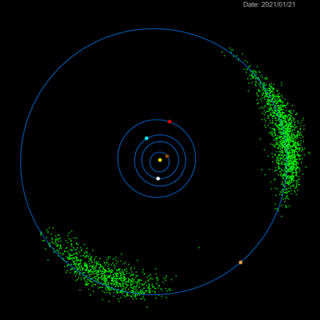Inside NASA's Wildly Complex Plan to Navigate Jupiter's Asteroid Fields
In 2021, Lucy is coming for the Trojan asteroids. Here's how.
By David Grossman
SOUTHWEST RESEARCH INSTITUTE
In 2021, NASA will launch its Lucy mission to explore Jupiter's Trojan asteroids for the first time. Billions of years old, these asteroids serve as a time capsule for the earliest days of the solar system. Getting there will require some of the fanciest flying in the space agency's history and NASA has just started publicly discussing how Lucy will navigate its way through some of the oldest asteroids in the solar system.
The challenge with planning a mission like Lucy is that solar system is constantly moving. Normally, scientists can plan out a clear-cut route with a large planetary body, like Mars or Earth's moon. But with the Trojan asteroids, which are comprised of two separate clouds, the spacecraft will have to navigate through multiple gravitational forces. Each of these gravitational forces will be moving in their own direction and will be threatening to take Lucy with them.
"There are two ways to navigate a mission like Lucy,” says Jacob Englander, the optimization technical lead for the Lucy mission, in a press statement. “You can either burn an enormous amount of propellant and zig-zag your way around trying to find more targets, or you can look for an opportunity where they just all happen to line up perfectly.”

A .GIF showing the complexity of Lucy’s route. The green dots
represent the Trojan asteroids. The inner dots represent the inner
planets, while the orange dot represents Jupiter.
ASTRONOMICAL INSTITUTE OF CAS/PETR SCHEIRICH
As Lucy moves through the solar system, the majority of its course corrections will use what are known as gravity assists. Gravity assists have a long history of helping NASA satellites get the job done. They're a favorite when navigating through interplanetary travel. Most famously, they were used to allow Voyager 2 to visit Jupiter, Saturn, Uranus and Neptune.
When a planetary body, or Lucy's case an asteroid, is much larger than the craft itself, the body shows no reaction to the craft's approach. This will allow for Lucy's energy to be conserved on its approach. As Lucy falls into an asteroid's gravity well, it will speed up and gain kinetic energy as it loses potential energy, similar to a ball rolling down the hill. It will navigate a turn and will expend that extra kinetic energy move in a new direction
But approaching these asteroids will be tricky. It will require what's known as optical navigation—perhaps the most long-distance form of remote flying ever attempted. Using a communication link and images from Lucy's onboard cameras, the team on Earth will learn the craft's location, direction and velocity. From there the team, which will include the private Arizonan space company KinetX, will design trajectory correction maneuvers.
“The maneuvers to correct Lucy’s trajectory are all going to be really critical because the spacecraft must encounter the Trojan at the intersection of the spacecraft and Trojan orbital planes,”says navigation technical lead Dale Stanbridge, who works at KinetX. “Changing the spacecraft orbital plane requires a lot of energy, so the maneuvers need to be executed at the optimal time to reach to next body while minimizing the fuel cost.”
These maneuvers will vary greatly. “The first maneuver is tiny,” Stanbridge says. “But the second one is at 898 meters per second." That's a little over 2,000 MPH.
After the tricky flying Lucy will be rewarded with clear skies, so to speak. Its mission will complete in 2033 with nothing ahead. “We’re just going to leave it out there,” Englander said. “We did an analysis to see if it passively hits anything, and looking far into the future, it doesn’t.”
After helping humanity better understand the origins of the solar system, it will be a much-deserved retirement.
Source: NASA
No comments:
Post a Comment